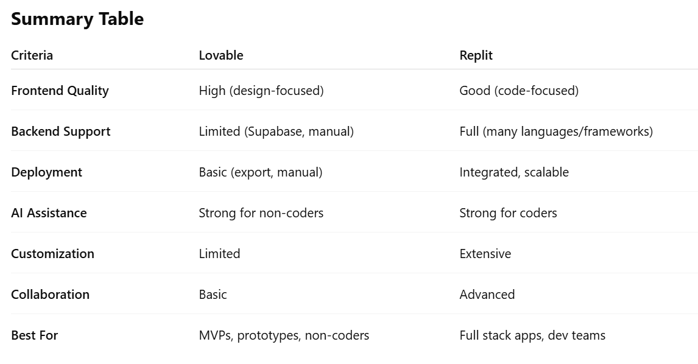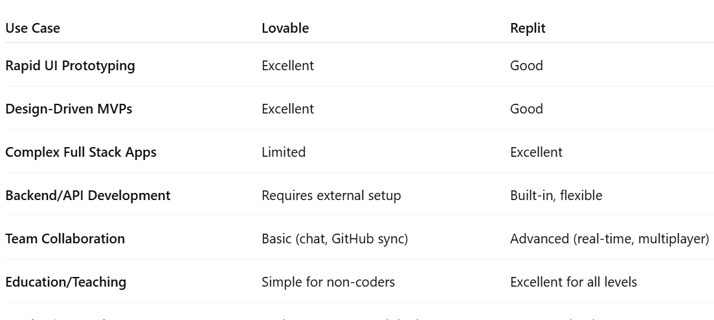How would you compare lovable v/s replit for full stack application development?
Replit v/s Lovable
6/1/20252 min read


Lovable vs. Replit for Full Stack Application Development
When choosing between Lovable and Replit for full stack app development, it’s important to understand their core philosophies, strengths, and limitations. Here’s a detailed comparison to help you decide which platform best fits your needs.
Core Approach
Feature Lovable Replit Philosophy AI-driven, no-code/low-code, design-first Developer-centric, code-first, all-in-one Target User Non-technical users, designers, founders Developers (all levels), educators, teams Interface Chat-based, visual, minimal coding Full IDE, code editor, AI assistant
Strengths
Lovable
Rapid Prototyping: Excels at quickly generating visually polished frontends and MVPs with minimal input. Great for landing pages, mockups, and design-focused projects.
Ease of Use: Designed for non-coders; the chat-based interface and AI handle most of the heavy lifting.
Design Integration: Seamless Figma integration and strong UI/UX output. Builder.io partnership allows direct conversion of Figma designs to code.
Automated Debugging: AI-driven error detection and refactoring, with clear explanations for non-technical users.
GitHub Sync: Easy export to GitHub for further development or collaboration.
Replit
Full Stack Support: Handles both frontend and backend, with support for 50+ programming languages and frameworks.
Developer Control: Offers granular access to project files, logic, and structure. Ideal for complex, production-ready apps.
Collaboration: Real-time multiplayer coding, making it suitable for teams and educational settings.
Integrated Deployment: Built-in hosting, deployment, and version control. Multiple deployment types (static, autoscale, reserved VM, scheduled).
AI Assistance: Ghostwriter and AI Agent provide code suggestions, debugging, and documentation, but keep the developer in control.
Limitations
Lovable
Backend Limitations: No built-in backend; relies on integrations like Supabase, which may require manual setup for advanced features.
Scalability: Struggles with complex or large-scale projects. Best for simple apps, MVPs, and design prototypes.
DevOps & Versioning: Rudimentary environment management; lacks advanced deployment and versioning features.
Customization: Limited control over intricate business logic or custom backend requirements.
Usage Limits: Free tier has message and bandwidth caps; scaling up requires a paid plan.
Replit
Learning Curve: More technical; best suited for users comfortable with code.
Browser IDE Limits: Some advanced workflows may feel constrained compared to local development environments.
AI Limitations: AI suggestions are helpful but may not always be production-ready; manual review is often needed.
Paywalls: Some advanced features and deployments require a paid subscription.
Best Use Cases
User Feedback & Real-World Experience
Lovable is praised for its speed, design quality, and accessibility for non-coders, but users note challenges with DevOps, backend setup, and scaling to complex requirements.
Replit is favored by developers for its flexibility, control, and robust deployment options, though it requires more technical skill and manual intervention for advanced features.
Summary
Conclusion
Choose Lovable if you want to quickly prototype visually stunning apps, are focused on UI/UX, or have little coding experience. It’s ideal for landing pages, MVPs, and design-driven projects.
Choose Replit if you need full stack capabilities, backend logic, advanced deployment, or team collaboration. It’s better suited for developers building production-ready applications or complex systems.
For many teams, a hybrid approach works well: use Lovable for rapid UI ideation, then move to Replit for full stack development and deployment.




Built with AI and Humans Working in Harmony
